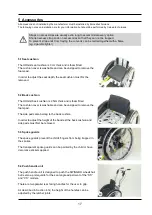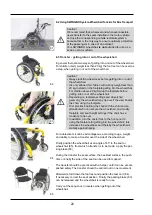
12
4.5 Backrest angle
• Hold the upper edge of the backrest.
• Turn the toggle until the bolt is completely withdrawn into its housing.
• Now one of the five backrest angles can be chosen.
• Release the bolt to lock into the required position.
CAUTION!
Check with a sharp push on the backrest to ensure that
the bolt is securely located.
4.6 Seat position and the centre of gravity (Active degree)
This describes the backrest position in relation to the position of the
rear axle and the centre of gravity. The further the backrest and,
therefore, the child’s shoulders are positioned behind the rear axle,
the more actively the SWINGBO wheelchair can be driven (e.g.
lifting the front castors). Alternatively, mounting the backrest over or
in front of the rear axle means a more stable driving position.
CAUTION!
Mounting the backrest to give a more active drive position
requires a competent wheelchair user and the installation
of anti-tippers.
It is possible for the dealer to make an adjustment.
4.7 Footrest hanger 90° (Knee angle)
By loosening the four screws, the knee angle assembly can be
moved in relation to the front edge of the seat.
Thereby the child can be seated with a knee angle of between
approximately 85° to 95°.
Retighten the four screws securely.
If necessary the angle of the foot rest should also be adjusted.
4.8 Lower leg length
Release both clamping screws on the footboard bracket in order to
adjust to the required lower leg length.
Retighten the clamping screws securely.
Whenever you change any settings on the wheelchair,
make sure that you firmly tighten any screws that have
been loosened.
4.9 Foot rest angle adjustment
The foot rest can be folded upwards to climb in or out of the
wheelchair or for transportation.
The position of the foot rest can be adjusted by loosening the four
screws on the foot rest bracket.
31
32
33
34
35
Summary of Contents for SWINGBO
Page 1: ...SWINGBO System Wheelchair for kids user manual GB US partnering together to mobilise kids...
Page 2: ......
Page 27: ......














































